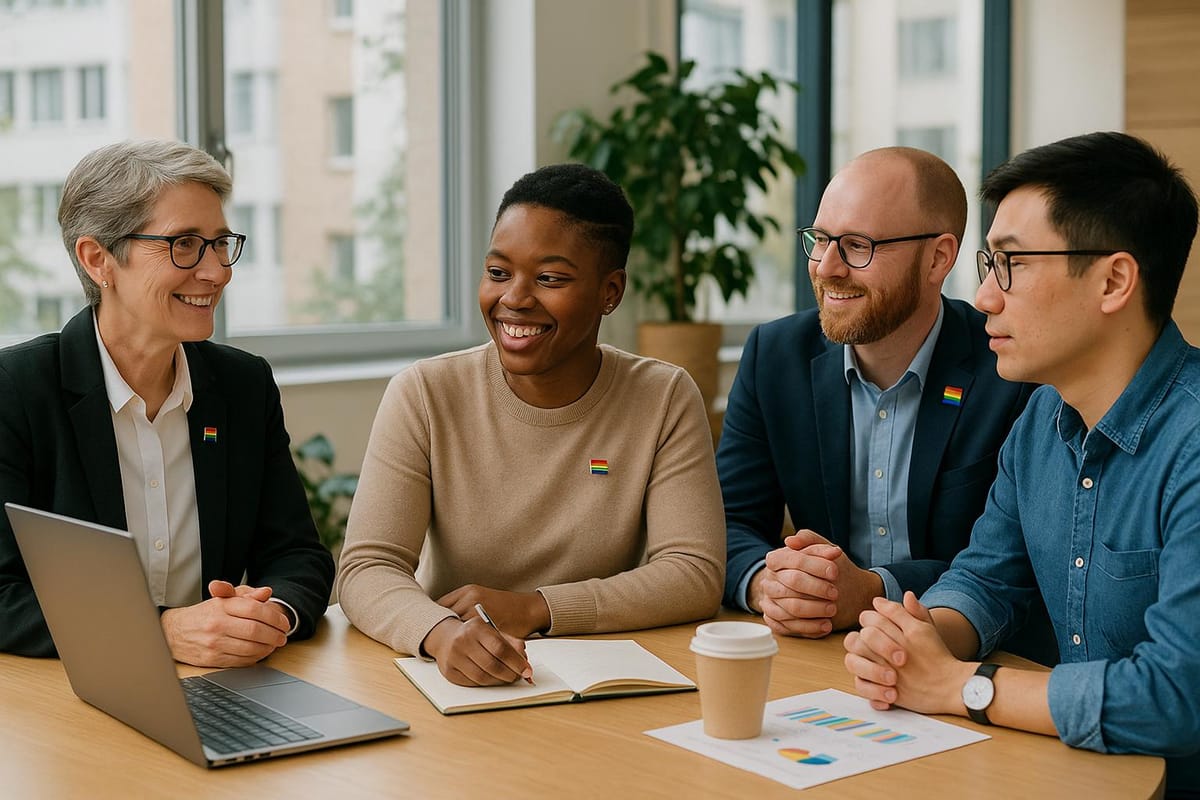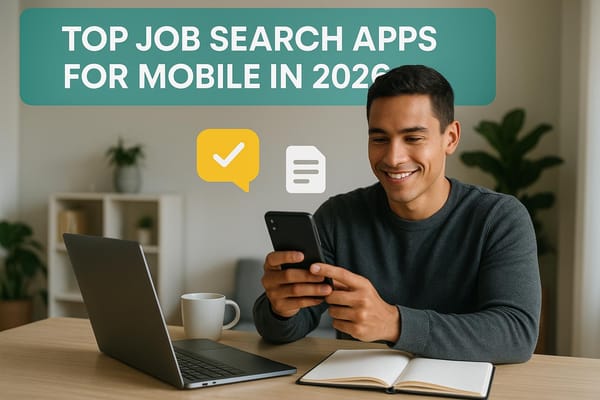Ultimate Guide to LGBTQ+ ERGs for Career Growth
LGBTQ+ Employee Resource Groups enhance career growth through leadership, networking, and policy advocacy, fostering inclusivity in the workplace.

LGBTQ+ Employee Resource Groups (ERGs) can supercharge your career while creating a supportive workplace. These employee-led groups provide leadership experience, networking opportunities, mentorship, and the chance to influence workplace policies. Here's what you need to know:
-
Key Benefits:
- Gain leadership skills by taking on roles within ERGs.
- Build cross-departmental connections for career advancement.
- Access mentorship and professional development programs.
- Advocate for inclusive workplace policies and culture.
-
How ERGs Work:
- Structured leadership ensures effective programs.
- Activities include educational events, networking, and policy advocacy.
- Companies like Microsoft and IBM have used ERGs to drive impactful changes.
-
Getting Involved:
- Join an existing ERG through your company’s HR or diversity resources.
- Start your own ERG by securing support, defining goals, and organizing leadership.
-
Career Impact:
- ERG involvement boosts visibility, leadership skills, and networking.
- Highlight achievements like event planning or policy contributions on your resume.
Quick Fact: A 2023 study found that 42% of ERG leaders earned promotions within two years. Whether joining or starting an ERG, your participation can drive personal growth and workplace change.
Emerson Pride Employee Resource Group
Understanding LGBTQ+ ERGs
LGBTQ+ Employee Resource Groups (ERGs) are employee-led initiatives focused on career growth and workplace equality. As of 2023, the Human Rights Campaign reported that 92% of Fortune 500 companies hosted ERGs.
Core Functions of LGBTQ+ ERGs
LGBTQ+ ERGs typically focus on three key areas:
Policy Advocacy: These groups help shape inclusive workplace policies. For example, Microsoft's GLEAM ERG successfully pushed for transgender-inclusive healthcare benefits.
Professional Support: ERGs offer career development opportunities. IBM’s LGBTQ+ group connects members with senior leaders through mentorship programs.
Community Building: They foster connections through events. Goldman Sachs' Pride Network organizes networking dinners, while LinkedIn hosts "Career Visibility" webinars.
"Intel's 2024 internal data showed that 89% of ERG members felt 'more connected to colleagues.'" - Intel ERG Impact Report
These functions rely on structured frameworks to ensure impactful programming and advocacy efforts.
ERG Structure and Activities
Most ERGs operate with organized leadership to run effective programs:
| Leadership Level | Role | Activities |
|---|---|---|
| Executive Sponsor | Strategic oversight | Approves budgets; supports leadership |
| Steering Committee | Program planning | Develops initiatives; suggests policies |
| Subcommittees | Focused initiatives | Runs intersectionality programs; training |
| General Members | Active participation | Attends events; engages in mentorship |
ERGs engage in a variety of activities:
Educational Programs: Target’s ERG runs annual workshops on pronoun usage.
Career Development: Accenture's ERG reported that 78% of LGBTQ+ employees felt more supported at work after joining, according to its 2024 Global Inclusion Report.
Policy Contributions: JPMorgan Chase’s ERG mentorship program is linked to a 40% increase in LGBTQ+ employee retention.
Gartner’s 2024 data shows that 43% of ERGs use digital platforms to connect remotely, with companies like Bank of America offering stipends to support ERG leaders.
How LGBTQ+ ERGs Can Boost Your Career
Being part of an LGBTQ+ Employee Resource Group (ERG) can open doors to meaningful professional connections and career opportunities. By getting involved, you can:
- Share your experiences in a supportive environment
- Collaborate with colleagues from different departments
- Build connections with professionals who value diversity
These groups not only enhance your network but also help you establish yourself as an active and engaged leader in your workplace.
How to Join or Launch an ERG
Getting involved with an LGBTQ+ Employee Resource Group (ERG) can help create an inclusive workplace while offering opportunities for personal and professional growth.
Finding Existing ERGs
Start by checking your company’s HR portal or diversity resources for information on existing ERGs. If you can’t find one, reach out to your HR representative for guidance. And if there isn’t an LGBTQ+ ERG yet, you can take the lead and start one.
Steps to Start an ERG
If your workplace doesn’t have an LGBTQ+ ERG, here’s how you can establish one:
1. Understand Your Company’s ERG Requirements
Before diving in, review your organization’s guidelines for ERGs. These often include:
- Securing an executive sponsor
- Writing a mission statement
- Setting annual goals
- Preparing a budget proposal
2. Rally Support
To kick things off, gather support from key stakeholders, including:
- HR or DEI leadership
- Executive sponsors
- Colleagues who are interested
- Leaders from other ERGs
3. Organize the Group
Set up a clear structure to keep things running smoothly. This includes:
- Defining leadership roles
- Establishing a meeting schedule
- Setting up communication channels
- Brainstorming initial events or programs
Getting the Most Out of Your Membership
Once you’re part of an ERG, there are plenty of ways to make your involvement meaningful.
Take on Leadership Roles
- Volunteer to lead committees or events
- Mentor new members
- Partner with other ERGs to coordinate initiatives
Track Your Impact
- Record attendance at events
- Keep a log of policy changes and mentoring achievements
- Maintain a portfolio of the group’s accomplishments
Expand Your Network
- Build connections across departments
- Engage with senior leadership
- Collaborate with ERG chapters at other locations
- Represent your ERG at company-wide events
ERGs and Workplace Support
Building Community
LGBTQ+ Employee Resource Groups (ERGs) play a key role in creating supportive workplaces. According to a 2024 McKinsey study, companies with active ERGs saw a 22% boost in LGBTQ+ employee satisfaction scores. Take IBM's LGBTQ+ ERG, "EAGLE", as an example. They organize monthly "Lunch & Learn" sessions where members discuss intersectional challenges and share stories, helping to build stronger connections across departments.
The benefits of strong ERG programs are clear:
| Impact Area | Results |
|---|---|
| Employee Retention | 30% higher among LGBTQ+ employees |
| Job Performance | 56% improvement in performance |
| Workplace Comfort | 81% report a better work environment |
| Mental Health Support | 67% increase in resource usage |
Beyond community-building, ERGs often lead the charge in driving meaningful workplace policy changes.
Improving Company Policies
ERGs are powerful agents for change within organizations. At Intel, the LGBTQ+ ERG has introduced impactful policies like gender transition guidelines with paid leave, company-wide pronoun inclusion training (adopted by 89% of managers), and a supplier diversity program that supports LGBTQ+-owned businesses.
Microsoft’s ERG has also made a difference through data-driven advocacy. By highlighting survey results showing that 40% of transgender employees faced healthcare barriers, they successfully pushed for expanded gender-affirming care coverage.
Liberty Mutual’s ERG has made a lasting impact over the years:
"Our decade-old ERG of 5,000+ members directly influenced a $40K fertility reimbursement policy and comprehensive gender-affirming care network, cutting LGBTQ+ turnover by 22% since 2020."
Charles Schwab’s PRIDE+ ERG is another example of effective action. By partnering with Camp Brave Trails, they’ve provided free counseling services to over 1,200 employees.
To maximize their influence on company policies, successful ERGs often:
- Conduct anonymous surveys to identify employee needs
- Collaborate with HR for yearly policy reviews
- Present cost-benefit analyses to leadership
- Measure the success of new policies
- Work with other ERGs on intersectional projects
The urgency of ERG advocacy has grown in recent years. In 2023, 490 anti-LGBTQ+ bills were introduced across the U.S., a sharp rise from 315 in 2022. This underscores the increasing importance of strong workplace protections.
Using ERGs for Career Growth
ERGs aren't just about fostering community - they can also be a powerful tool for advancing your career. Here's how to make the most of your involvement.
Building Your Reputation
Getting actively involved in LGBTQ+ ERGs can position you as a leader in your workplace. Whether you're organizing workshops, mentoring colleagues, creating training resources, coordinating events, or advocating for policy updates, you’re putting yourself in a position to be noticed. This kind of engagement increases your visibility and opens doors to collaborate with others across the company.
Collaborating Across Teams
Participating in an ERG often means working with different departments. Many organizations encourage their ERGs to collaborate with teams like Marketing, Human Resources, Legal, and Product to promote inclusive initiatives. These partnerships not only help you build strong relationships across the company but also give you a broader understanding of how the business operates. This kind of cross-functional work can significantly enhance your professional experience.
Showcasing ERG Contributions on Your Resume
Make the work you’ve done in ERGs count by presenting it effectively on your resume. Here’s how:
-
Highlight Leadership Roles
Include your ERG accomplishments. For instance, mention leading a chapter that grew significantly or driving initiatives that made your workplace more inclusive. -
Emphasize Project Management
Detail the projects you’ve managed, such as planning events, shaping policies, or running mentorship programs. Focus on how these efforts positively impacted your organization. -
Quantify Your Results
Use numbers to back up your achievements. Whether it’s an increase in membership, higher event attendance, or successful policy implementations, measurable outcomes make your contributions stand out.
Conclusion
Research highlights that active Employee Resource Groups (ERGs) can increase employee inclusion scores by 23%. At Salesforce, policy changes driven by ERGs have boosted LGBTQ+ employee retention by 31%.
For those focused on career growth, ERG participation offers measurable advantages. A 2023 Human Rights Campaign study found that 42% of ERG leaders earned promotions within two years of stepping into leadership roles. Similarly, LinkedIn data reveals that 76% of hiring managers value candidates with a demonstrated commitment to inclusivity.
Getting involved in an ERG is both achievable and impactful. Whether you're joining an existing group or starting one from scratch, real-world examples show the potential for long-term influence. Microsoft’s journey from a single Pride Month panel in 1993 to a global network of 40+ chapters is a testament to this. Meanwhile, Bank of America's "ERG Ambassadors" program shows that dedicating just two hours a month can lead to meaningful professional growth.
"ERG leadership demonstrates strategic thinking and emotional intelligence – skills we prioritize for senior roles", says Jamal Williams, Apple's DEI Director. This insight underscores how ERGs can serve as a proving ground for future leaders.
Beyond individual benefits, ERGs contribute to broader organizational progress. For example, Intel's ERGs have played a key role in supporting diverse talent, including achieving a 90% visa renewal success rate for international employees through targeted support networks. These examples show how ERGs can create meaningful change for individuals and companies alike.
FAQs
How can joining an LGBTQ+ Employee Resource Group (ERG) help boost my career and develop professional skills?
Getting involved in an LGBTQ+ ERG can significantly enhance your career by providing opportunities for networking, mentorship, and skill-building. These groups often connect members with industry leaders, offer professional development workshops, and create a supportive space to share career advice and experiences.
Beyond networking, participating in an ERG can help you build leadership and collaboration skills by organizing events, leading initiatives, or contributing to important workplace discussions. These experiences not only strengthen your resume but also demonstrate your ability to foster inclusivity and drive positive change within an organization.
If you're actively seeking new opportunities, consider leveraging tools like resume builders or job application trackers to streamline your search process. This allows you to focus on showcasing your skills and making the most of the connections you build through your ERG involvement.
How can I start an LGBTQ+ Employee Resource Group (ERG) at my workplace?
Starting an LGBTQ+ Employee Resource Group (ERG) at your workplace can be an empowering way to foster inclusivity and support. Begin by identifying colleagues who share your vision and are interested in creating a safe and welcoming space for LGBTQ+ employees. Collaborate with them to outline the group's goals, such as promoting diversity, offering mentorship, or hosting educational events.
Next, present your idea to HR or leadership, emphasizing the benefits of an LGBTQ+ ERG, such as improving employee engagement, attracting diverse talent, and fostering a more inclusive workplace culture. Be prepared to share a clear plan, including the group's mission, potential activities, and how it aligns with company values. Once approved, start small with initial meetings, promote the group through internal channels, and encourage participation from allies to build momentum and create lasting impact.
How do LGBTQ+ Employee Resource Groups (ERGs) help shape company policies and promote inclusivity in the workplace?
LGBTQ+ Employee Resource Groups (ERGs) play a vital role in influencing company policies and fostering inclusive work environments. By providing a platform for LGBTQ+ employees and allies to share their experiences, these groups help identify workplace challenges and propose meaningful solutions.
ERGs often collaborate with leadership to advocate for inclusive policies, such as equitable benefits, anti-discrimination practices, and support for gender identity and expression. Additionally, they promote awareness through training, events, and initiatives that educate employees, creating a culture of understanding and respect. These efforts not only benefit LGBTQ+ employees but also contribute to a more diverse and innovative workplace for everyone.




